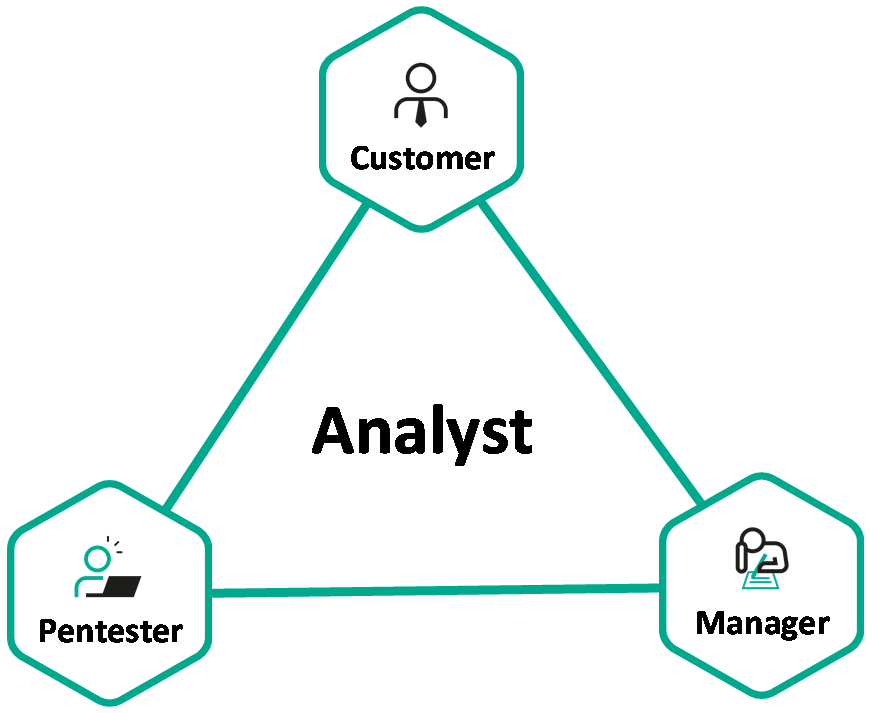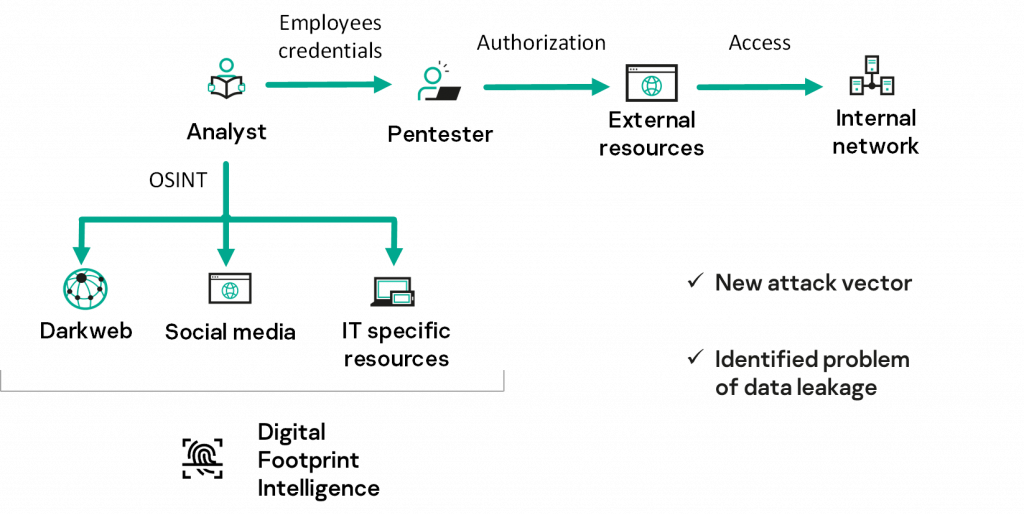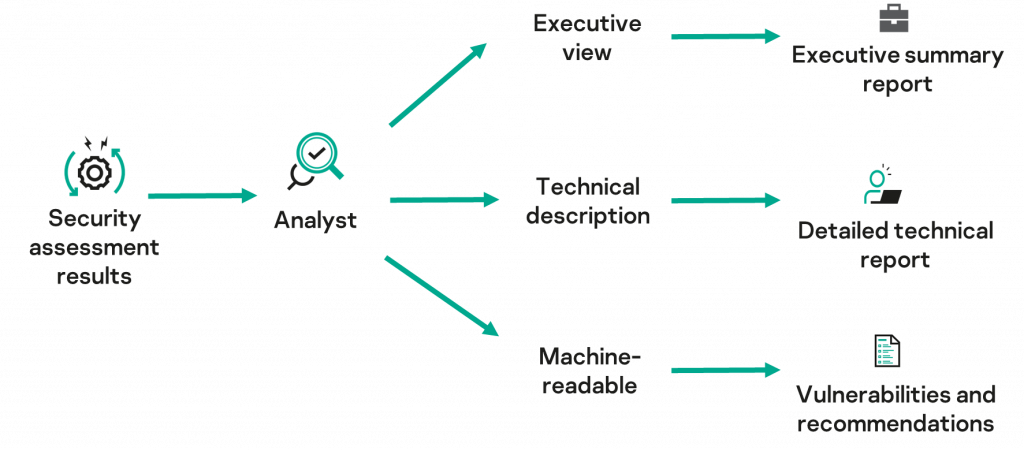
2023-2-10 18:0:33 Author: securelist.com(查看原文) 阅读量:16 收藏
Penetration testing is something that many (of those who know what a pentest is) see as a search for weak spots and well-known vulnerabilities in clients’ infrastructure, and a bunch of copied-and-pasted recommendations on how to deal with the security holes thus discovered. In truth, it is not so simple, especially if you want a reliable test and useful results. While pentesters search for vulnerabilities and put a lot of effort into finding and demonstrating possible attack vectors, there is one more team member whose role remains unclear: the cybersecurity analyst. This professional takes a helicopter view of the target system to properly assess existing security holes and to offer the client a comprehensive picture of the penetration testing results combined with an action plan on how to mitigate the risks. In addition to that, the cybersecurity analyst formulates a plan in the business language that helps the management team, including the C-level, to understand what they are about to spend money on.
Drawing on Kaspersky’s expertise with dozens of security assessment projects, we want to reveal the details of the analyst’s role on these projects: who they are, what they do, why projects carried out together by pentesters and an analyst are much more useful for clients.
Who is an analyst?
 In general, an analyst is a professional who works on datasets. For example, we all know about financial analysts who evaluate the efficiency of financial management. There are more than one type of analyst in the field of information security:
In general, an analyst is a professional who works on datasets. For example, we all know about financial analysts who evaluate the efficiency of financial management. There are more than one type of analyst in the field of information security:
- Security Operation Center analysts work on incident response and develop detection signatures in a timely fashion;
- Malware analysts examine malware samples;
- Cyberthreat intelligence analysts study the behavior of various attackers, diving deeper into their tactics and techniques.
Speaking of the analyst on a security assessment project, their role is to link together the pentester, the manager, and the client. At Kaspersky for example, an analyst contributes to nearly all security assessment projects, such as penetration testing, application security assessment, red teaming, and other. The goals and target scope of these projects can be different: from searching for vulnerabilities in an online banking application to identifying attack vectors against ICS systems and critical infrastructure assets. Team composition can change, so the analyst works with experts from many areas, enriching the project and sharing the expertise with the client.
The analyst’s role in the security assessment process
It is possible to distinguish the following stages of analyst work in the security assessment process:
- Advanced reconnaissance,
- Interpreting network scan results,
- Threat identification,
- Verification of threat modeling,
- Visualization,
- Vulnerability prioritization,
- Recommendations,
- Project follow-up.
Next, we will go over each of these steps in detail.
Advanced reconnaissance
The analyst begins by gathering information about the organization before the security testing conducted by pentesters can begin. The analyst studies public resources to learn about the business systems and external resources, and collects technical information about the target systems: whether the software was custom-built, provided by a vendor, or created from an open-source codebase, what programming language was used, and so on. They also look up known data leaks that may link to client employees and compromised corporate credentials. Often, this data is offered for sale on the dark web, and the analyst’s job is to detect these mentions and warn the client. All this information is collected to discover potential attack vectors and negotiate a project scope with the client. Potential attack vectors will then be explored by pentesters. For example, publicly available employee data can be used for social engineering attacks or to gain access to company resources, and information about the software can be used to find known vulnerabilities.
Project case: The benefits of OSINT
Here is an example from one of our security assessment projects where information-gathering by the analyst helped to identify a new attack vector. The analyst successfully used the Kaspersky Digital Footprint Intelligence service to find compromised employee credentials on the dark web. With the client’s approval, a pentester attempted to authenticate with one of the company’s external services using these credentials and finding that they were valid. Seeing how the client’s network perimeter was highly secured and all public-facing services, properly protected with authentication, the case clearly demonstrated that even a well-hardened infrastructure could be vulnerable to OSINT and threat intelligence.
A diagram of the penetration testing project where the information gathering by the analyst helped to identify a new attack vector
Interpreting scan results
At this stage, we have agreed with the client on a project scope, and pentesters are running an instrumental network scan to identify the client’s public-facing services and open ports. In our experience, the state of network perimeter cybersecurity in most organizations is far from perfect, but due to project constraints, pentesters typically target only a small number of perimeter security flaws. The analyst examines the network scan outputs and highlights the key issues. Their goal is to gather detailed information about insufficient network traffic filtering, use of insecure network protocols, exposure of remote management and DBMS access interfaces, and other possible vulnerabilities. Otherwise, the client will not see the full picture.
Threat identification
Information about all attack vectors that were successfully exploited during the test comes from the pentester, whereas the analyst transforms these to build a detailed report describing the vulnerabilities and security flaws. In the hands of the analyst, a description of each attack vector, enriched with evidence, screenshots and collected data, turns into detailed answers to the following questions:
- What vulnerabilities were found and how?
- What are the conditions for exploitation?
- Which component is vulnerable (IP address, port, script, parameter)?
- What exploit/utility was used?
- What was the result (data / access level / conditions for exploiting another vulnerability)?
Notably, multiple vulnerabilities pieced together may result in a single attack vector leading from zero-level access to the highest privileges.
Verification of threat modeling
After the previous stages are complete, the vulnerabilities should be grouped under categories. Below are a few examples:
- Web application vulnerabilities (SQL injection, XSS, CSRF);
- Access control misconfigurations (for example, excessive account privileges, use of the same local account on different hosts);
- Patch management issues (use of software that has known vulnerabilities).
Next, all vulnerabilities and security misconfigurations will be converted into threats that can exploit these. Armed with the knowledge of the client’s business systems, the analyst can assess to which critical resources a cybercriminal will gain access in the event of an attack. Will the attacker be able to reach the client’s data, gain access to employees’ personal data, or maybe to payment orders? For example, by gaining total control over the client’s internal infrastructure, including critical IT systems, an attacker can disrupt the organization’s business processes, while the ability to read arbitrary files on the client’s servers can lead to sensitive documents being stolen.
Visualization
The analyst creates a diagram to visualize all of the pentester’s activities relating to the successful attack scenarios. This is an important time not just for the client, who clearly sees everything that happened (what vulnerabilities were exploited, which hosts were accessed, and what threats this led to), but also for the pentesters. This is because, looking at this level of detail, they can see vectors that previously went unnoticed, findings that the report missed, and attacks that can be launched in the future.
Project case: discovering an additional attack vector
During an internal penetration test, our experts found multiple vulnerabilities and obtained administrative privileges in the domain. However, while analyzing the output of the BloodHound tool, the analyst uncovered hidden relationships, stumbling on an attack path within an Active Directory environment. The analyst found that external contractors could escalate their privileges in the system due to Active Directory being misconfigured. Constrained by the project scope, the pentesters did not go on to gain access to contractor credentials, so they were not able to exploit said misconfiguration. The client greatly appreciated the discovery of the new attack vector.
A project case where BloodHound tool output analysis revealed an additional attack vector
Vulnerability prioritization
When all vulnerabilities and threats have been identified, an analyst moves on to the prioritization stage. At this step, it should be decided which vulnerabilities need fixing first. The simplest solution would be to prioritize those with the highest severity level, but it is not the correct one. There are situations where a “critical” vulnerability identified in a test web application does not cause the same amount of damage as a “medium” vulnerability in a critical system. An example is a vulnerability in an online bank whose exploitation can trigger a whole chain of interconnected vulnerabilities, which would allow the attacker to steal the clients’ money.
So, the analyst looks at the overall business impact of the attack vector and the risk level of the vulnerabilities involved. Next, they prioritize the vulnerabilities, starting with the ones that pose the most severe threats but are easiest and fastest to fix, and following with those which require major changes to the business processes and are a subject of strategic cybersecurity improvements. After that, the analyst arranges the list of vulnerabilities and recommendations in the order in which measures should be taken.
Vulnerabilities prioritization scheme
Recommendations
The analyst prepares recommendations, which are part of project deliverables and should consider the following:
- A timeframe for implementation:
- Short term (<1 month): easily implemented recommendations, such as installing security updates or changing compromised credentials;
- Medium term (<1 year): the most important changes requiring significant effort such as, for example, enforcing strict network filtering rules, restricting access to network services and applications, or revising user privileges and revoking excessive ones;
- Long term (>1 year): changing the architecture and business processes, implementing/improving security processes and controls, such as, for example, developing a robust procedure for periodical updates.
- The client’s approach to certain systems and business processes;
- Industry best practices and cybersecurity frameworks.
Project follow-up
At the final stage, the analyst provides three levels of project deliverables:
- An executive overview for C-level managers and decision-makers who represent the client.
- Technical details of the security assessment for the client’s IS team, SOC officers, IT specialists, and other employees.
- Machine-readable results that can be processed automatically or used in the client’s cybersecurity products.
Three levels of project deliverables
Conclusions
In summary of the above, the main advantages of having an analyst on a security assessment project, as evidenced by our experience, are as follows:
- The ability to collect and analyze a large amount of data, whether found in external sources or received from pentesters;
- Pentester time savings: these team members may not be concerned with the final results or reports as such;
- Collaboration with the client’s SOC or blue team to check whether the attacks were noticed, and to capture the defenders’ actions and the timing of the attacks;
- Visualization of the test results and translation of these into the business language.
Last but not least, the analyst provides a detailed mitigation plan including short-term and long-term recommendations, and actions required for mitigating the discovered threats. As part of our security assessment services, we give clients an overview of cybersecurity risks specific to their organizations (industry, infrastructure, and goals), and advice on hardening security and mitigating future threats.
如有侵权请联系:admin#unsafe.sh



